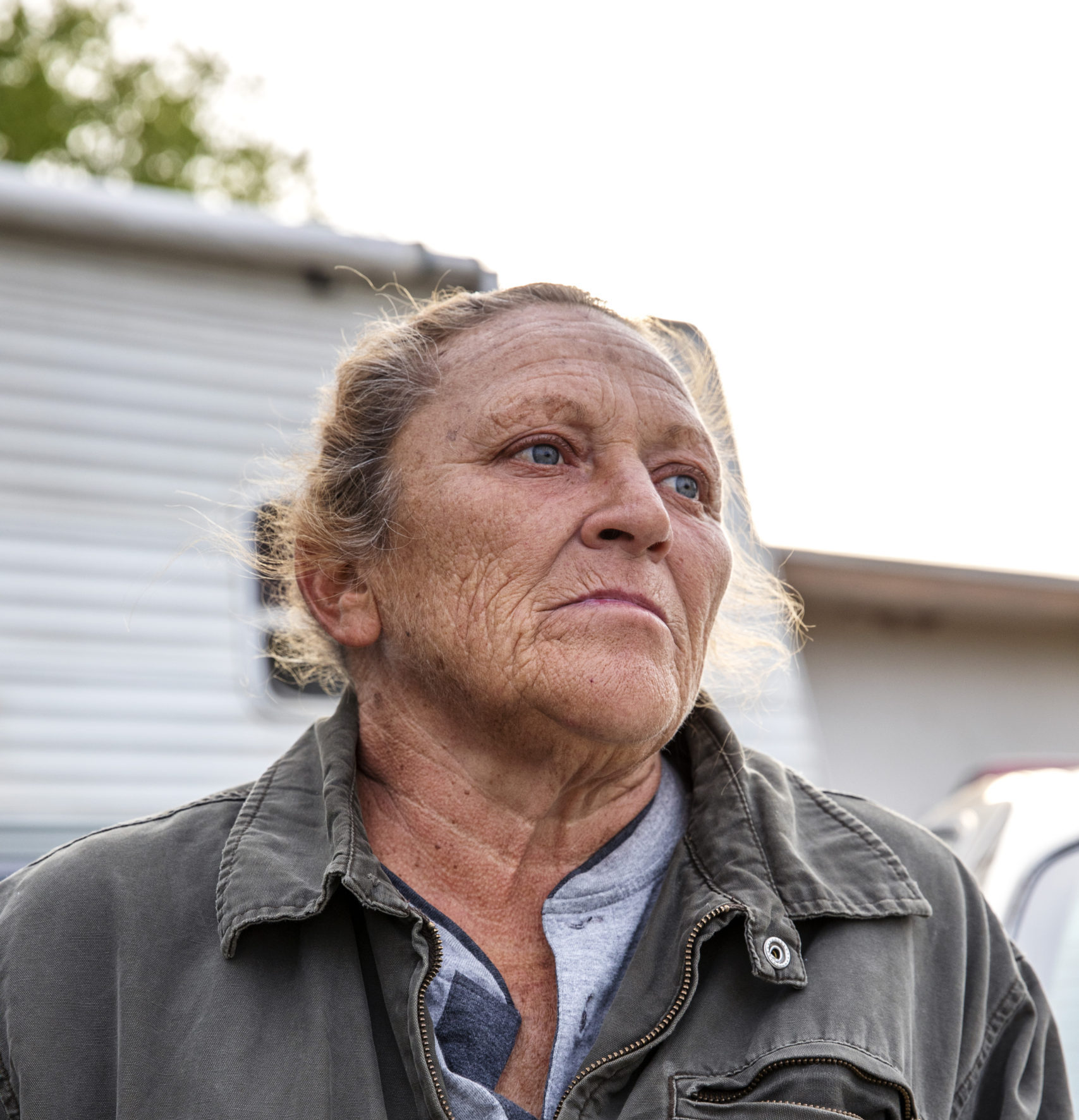Off and on for the last 11 years, Curbside Chronicle vendor Cathy Conner was homeless. Now she and her family are on the verge of moving into a house — her first home with running water in over a year.
To make the move, Conner will receive rental assistance through the US Department of Housing and Urban Development’s (HUD) Section 8 voucher program. But the process has been filled with stops and starts, including a monthlong delay brought on by the coronavirus pandemic.
The Oklahoma Housing Finance Agency (OHFA) approved Conner’s application for a Section 8 voucher in January, and soon after, she zeroed in on a two-bedroom home that would be big enough for her boyfriend, Wade Delgadillo, his teenage son and herself.
HUD requires housing covered by Section 8 funding undergo an inspection to make sure it meets quality standards, like having a working water heater and adequate plumbing. Before covid-19 hit, Conner requested an inspection, which usually takes weeks to schedule.
In March, the property manager said OHFA couldn’t do inspections during the pandemic.
“It was very, very devastating, because after we looked at the house, we really thought it was so cute,” she said. “It had a nice backyard, and I have an emotional support dog, and she was going to have a yard. It was just kind of perfect for us.”
The family grew anxious dealing with expensive weekly motel rates, the prospect of sleeping in their car again and the idea of being exposed to covid-19 if they didn’t have a place of their own soon. Delgadillo bought a travel trailer for $300 with his tax refund in the hope of giving his family a safe place to stay while they awaited more permanent housing.
Delgadillo, Conner, her daughter and son-in-law moved into the trailer, which has no plumbing, leaving the family to rely on a public restroom.
HUD has since issued a waiver that allows OHFA and other housing authorities to postpone inspections of new units if the property owner certifies in writing that the unit is safe.
Last week, Conner received word that OHFA would allow her to move into the house without an inspection. She said her family should be able to move into the home in May, with an inspection to follow in two months.
“Until I get my lease, I’m going to be holding my breath,” she said.
While they wait, Delgadillo’s 16-year-old son is staying with a family friend.
“He wants to be with his son,” Conner said. “He doesn’t want to be away from him one minute longer than he has to be.”
A system spread thin
As the pandemic unfolded, housing authorities and nonprofits with affordable housing programs temporarily suspended some services, slowing down the process for things like Section 8 vouchers.
Housing authorities like OHFA and the Oklahoma City Housing Authority administer federal rental assistance programs, which help low-income families, individuals with disabilities and the elderly afford housing.
Now, those invested in helping people secure homes fear that the economic fallout from covid-19 could lead to a crescendo of evictions and a heightened need for affordable housing. This need will fall during a time when federally funded programs offering rental assistance already have waitlists in the thousands.
“It does keep me up at night, because we know there was a need before, but the need is even greater now,” OHFA Executive Director Deborah Jenkins said. “And what we don’t see yet is a plan to address that.”
The city housing authority and OHFA both have waitlists for housing assistance that number in the thousands.
The Oklahoma City Housing Authority’s Section 8 waitlist reached about 5,600 in mid-April, Executive Director Mark Gillett said.
Jenkins said OHFA’s housing voucher program has a waitlist standing at more than 16,000, and the agency only has enough HUD funding to assist 10,900 families with rent at one time.
“The need is rapidly increasing. We don’t have the funds or the resources to address the entire need,” Jenkins said. “We didn’t have that previously, but what we’re seeing now is that unless HUD or Congress creates more funding or HUD finds additional dollars somewhere to allocate more vouchers, not just in Oklahoma but nationwide, you’re going to see a spike in the number of homeless individuals and families.”
The Oklahoma City Housing Authority and OHFA’s waitlists both prioritize people who are experiencing chronic homelessness – those who have either been homeless for a year or more or who have had four or more episodes of homelessness in the past three years.
As part of a federal relief package known as the CARES Act, HUD plans to give housing authorities $400 million for housing assistance payments and $850 million for administrative costs and other expenses. Public housing agencies will receive $685 million to maintain properties and cover costs from covid-19.
Gillett said he doesn’t know how much the city housing authority will receive, but he doubts it will stretch very far considering the agency spends about $2 million each month on its housing vouchers.
“It’s just not enough,” he said.
From mid-March to mid-April, the state received more than 140,000 claims for unemployment benefits, according to data from the Department of Labor.
“That, if this goes on for too long, is going to be a dire need for a lot of people, and if you’re not housed now, I think you’re going to have a hard time getting in housing,” said Periann Pulliam, CEO of nonprofit Upward Transitions.
That’s something Marilyn Patchen of Skiatook, near Tulsa, doesn’t take for granted. For months, her social security check failed to cover more than the bare essentials. Health problems forced her to quit her job at the beginning of the year, leaving her with less than $600 per month to cover her rent, car insurance and other expenses. She relies on food stamps that never seem to stretch quite far enough.
In February, Patchen applied for a Section 8 housing voucher to help cover the rent on her independent-living apartment. In early April, OHFA approved the voucher.
“It made me cry, I was so happy, because I was wondering, ‘How am I going to be able to do this?’” Patchen said. “You just don’t get enough food stamps to make it.”
Meghan Mueller, director of community capacity building for The Homeless Alliance, said nonprofits that assist low-income people and the homeless are facing staffing and workload issues that leave them more hesitant to take on new clients than they were before covid-19.
“We were already working really hard,” she said. “It already felt like we were being told to do more with less. … That’s kind of the nature of homeless services in general, so this is just stretching an already stretched system even further, and I think we’re really creative, adaptive and really hard workers, but that only takes you so far.”
During the pandemic, the city has been attempting to set up temporary homeless shelters. Oklahoma City senior city planner Jerod Shadid said the projects, which are expected to open in May, hit roadblocks and have been difficult to staff.
Yet, he said that work has been a welcome distraction from thoughts about the economic aftermath of covid-19. He worries that the city will see an influx in evictions and other issues as residents lose financial stability.
“Quite frankly, we’re now going to be serving people that we’ve never served before with our programs, because people who’ve never been homeless before are now going to be homeless, or they’re going to have to be concerned about it,” Shadid said. “It’s something I’ve been thinking about every day.”
Losing face time: From in person to virtual
During March’s cascade of canceled events and closed businesses, housing authorities and service organizations began shifting away from helping clients face to face. They continue to balance their missions with the need to protect the health of their clients and staff.
In early April, HUD issued a series of waivers that eliminate certain documentation requirements and ease other rules during the pandemic.
“This waiver is in place to help people still move in, because otherwise, you would have to go through many face-to-face meetings and get documentation from social security and from a lot of other places where all those avenues of communication are greatly inhibited right now,” said Gregory A. Shinn, the Mental Health Association’s associate director and chief housing officer.
Before the HUD waivers, however, housing authorities across the country struggled to proceed in a way that followed federal rules and social distancing standards at the same time.
OHFA stopped doing unit inspections for at least two weeks, preventing its clients from moving into Section 8-funded housing, even if they had an approved voucher.
The agency extended the vouchers’ expiration date and started doing virtual inspections before HUD issued the waiver postponing inspection requirements, Jenkins said.
For several weeks in March, Upward Transitions paused its housing program that pays rent and utility deposits for families seeking housing, citing concerns with in-person inspections.
In April, the nonprofit received $110,000 from United Way to assist with past-due rent and utilities for Oklahoma City residents who have lost income due to covid-19.
The Homeless Alliance has also provided short-term rent assistance to some of its clients during the pandemic.
For people experiencing poverty or homelessness, the barriers to getting affordable housing don’t end with coming up with the rent. There are deposits and application fees to cover, credit and criminal background checks to pass. A history of evictions can count against applicants, even if they’re able to cover the hundreds of dollars needed up front to secure housing.
Section 8 and public housing programs require every member of a household to provide a birth certificate, but that in itself can be a barrier for someone who doesn’t have that document or an ID.
Upward Transitions assists clients with getting their birth certificates, which they can use for housing and to land a job. Pulliam said that because case managers can’t go to Oklahoma Vital Records in person to retrieve the documents, it will take four to six weeks to order them by mail during the pandemic.
Bracing for a wave of evictions, homelessness
Before the pandemic, 7.7 million low-income households spent more than half of their incomes on rent and utilities, according to a study from the National Low Income Housing Coalition.
The coalition’s Vice President of Public Policy Sarah Saadian said this precarious housing situation means that a shock to their budgets, like a car breaking down, could lead to eviction and homelessness. With that in mind, the economic disruptions from covid-19 increase the risk that more people could become homeless.
There are some protections from eviction for the moment. Evictions are on hold in Oklahoma County, and a federal relief package placed a temporary moratorium on evictions for those living in federally assisted housing.
“But the question is, what happens when those moratoriums are lifted and when families owe back rent?” Saadian said.
Looming on the horizon, she added, is a spike in the number of renters who will need emergency rental assistance to stay in their homes.
In Oklahoma City, signs of financial stress are already here. City data shows that from January to mid-April, the 211 information system received 1,608 calls from people seeking assistance with rent – a 57 percent increase from the same time last year. By mid-April, 211 had received 2,524 calls seeking utility assistance, up 12 percent from that point the year before.
Shadid noted those jumps occurred despite freezes on evictions and utility shutoffs.
“I imagine when those restrictions go away, those numbers are probably going to go up pretty rapidly,” he said.
Jenkins said that OHFA typically receives about 300 applications a week for rental assistance through Section 8 voucher programs. In April, that number doubled.
For those receiving a subsidy through OHFA, lost income alone doesn’t mean they’ll lose housing because the agency can adjust their portion of the rent.
But for people on the waiting list, “the chance of you receiving assistance quickly or even at all is very slim,” Jenkins said.
“We’re trying to address that need, and there just aren’t enough vouchers,” she added.
Shinn said the Mental Health Association is seeking funds to make up for an expected loss of at least 10 percent in rental income as payments begin to slow. In early April, he said the organization’s rent collection was $30,000 behind where it normally stood at that point in an average month.
“More tenants are starting to notify our property managers that they may not be able to pay rent this month, they may be later than normal or that they expect they’ll have a problem paying rent next month,” Shinn said.
Mollie Bryant is the founder and editor of news nonprofit Big If True. Contact her at 405-990-0988 or bryant@bigiftrue.org, and follow her on Facebook and Twitter.
Editor’s note: This article is part of a collaborative project about homelessness in Oklahoma City by The Curbside Chronicle, Oklahoma Gazette and Big If True. This project is funded through a grant by the Inasmuch Foundation and the Ethics & Excellence in Journalism Foundation and facilitated by the Center for Cooperative Media at Montclair State University.


